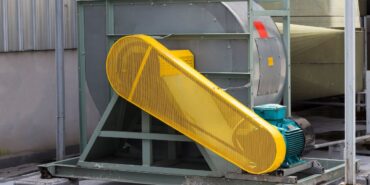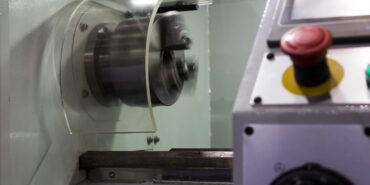When employers ensure their workforce is trained and is following recommended and required safety precautions when using machinery mishaps, injuries, non-compliance, and liabilities can be avoided. Moving parts, sharp edges and hot surfaces of machinery when used by untrained and uninformed workers can lead to serious workplace injuries and death. The Occupational Safety and Health Administration (OSHA) reports approximately 18,000 injuries and over 800 deaths related to machinery usage annually in the United States.
One proactive method for addressing risks is machine guarding.
What is Machine Guarding?
Machine guarding is the practical application of safeguards on and around machines to provide protections to the human operators and others in the machine area from hazards and prevent contact. Hazards include those created by point of operation, ingoing nip points, rotating parts, flying chips, and sparks (29 CFR 1910.212(a)(1)). Examples of guarding methods are barrier guards, two-hand tripping devices, and electronic safety devices.

Why is Machine Guarding Vital to Workplace Safety?
Installing machine guards to workplace safety and required for OSHA compliance (29 CFR 1910). In the US, there are 28 OSHA-approved State Plans, that require standards and enforcement programs that are at least effective as OSHA’s and may have a higher bar and more stringent requirements. An employer’s failure to comply with OSHA or its State Plan can lead to significant financial penalties, work injuries, and liability.
Machine guarding is the first line of defense against injuries caused by machine operation. Each machine should have adequate and appropriate safeguards to protect operators and other employees in the immediate work area from hazards created by ingoing nip points, rotating parts, sparks, and flying debris. A worker’s death, amputation or other serious injury is a life-changing event for all involved. Preventing such risks and injuries protects an employer’s most valuable asset, its workforce, maintains good morale and productivity, and maintains insurance premiums.
Methods of Safeguarding
There are five general approaches to machine guarding:
- Physical barriers: a protective obstacle is situated between the operator and the equipment. Examples include covers, cages, and plates.
- Physical distancing: adding increased physical distance between the operator and the machine reduces the risk of accidental contact.
- Devices: straps, two-hand operation controls, safety switches, etc., help limit direct contact with dangerous equipment.
- Automation: automated mechanisms for introducing and removing materials to and from the machine can reduce risk by limiting potential contact between dangerous components and the operator.
- Miscellaneous safeguards: such as debris shields, employee education and hand tools for material handling that minimize equipment contact.
Types of Machine Guards
When present, machine guards typically appear at specific points in a manufacturing process to protect workers from specific hazards. As a result, they fall into three main categories:
- Flying debris guards: these help prevent injury from sparks and debris that can occur with manufacturing processes like welding, grinding, and shaving.
- In-running point guards: these guards appear where materials combine in narrow openings or meet rotating components.
- Point-of-operation guards: these styles protect the machine operator at a spot where they work during processes like sawing, forming and boring.
OSHA Requirements
OSHA classifies machine guards into four basic types according to how they function – interlocked, fixed, adjustable and self-adjusting.
- Interlocked Guards – interlocked guards feature advanced safety measures such as automatic machine shut-off when they detect tampering. These guard types are commonly found at access points to the equipment interior. One example of this style is a trip guard, which prevents a machine from operating while undergoing maintenance.
- Fixed Guards – fixed guards are completely immovable and permanent guards mounted to a machine. These guards are typically point-of-operation guards designed to handle the equipment’s performance, including impacts and vibrations. Examples of fixed guards are blade covers, gates or other physical barriers.
- Adjustable Guards – unlike their fixed counterparts, adjustable guards allow some degree of manual modification to accommodate the operating environment. For example, guarding may permit access to a machine’s interior for a short time. It takes training and expertise to operate these accurately and effectively.
- Self-Adjusting Guards – similar to adjustable guards, these styles give operators some latitude in equipment interaction. However, they do so automatically and stay engaged whenever the machine runs. They don’t require the same level of knowledge but may need extra upkeep.
The general OSHA machine guarding requirements include:
- Guards should mount directly to the intended equipment whenever possible, though removable machine guarding is an option in some cases.
- All points of operation should contain guards.
- Guards must be practical and in operable condition and cannot create hazards in their position or use. Guarding approaches should be comprehensive and protect against all potential injuries.
- Hand tools used in material handling should be of an appropriate length to prevent the operator’s hand from entering a dangerous area.
- Guards should not impeded regular machine operation.
Through a comprehensive risk analysis utilizing data-based decisions, RHP’s team of industry experts enhance existing EHS strategies and develop and implement new, effective EHS strategies as needed. RHP Risk Management’s environmental health safety (EHS) experts work with clients to develop customized workplace safety solutions by evaluating your organization’s unique occupational hazards; develop meaningful and actionable insights the quantifiable data to mitigate occupational hazards; provide onsite EHS experts to implement, train and audit effectiveness of the recommendations; validate the plan meets OSHA, ANSI regulatory authority requirements and NIOSH recommendations; perform facility audits of the existing EHS program and identify any gaps; develop a comprehensive training program for all safety and health aspects of your facility; and schedule ongoing EHS support customized to your business’s needs.
Contact an RHP specialist by submitting our online request form or calling (773) 867-6010.

